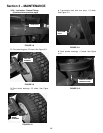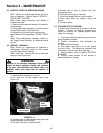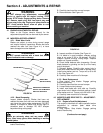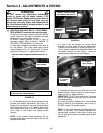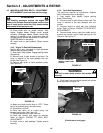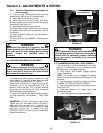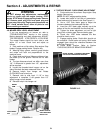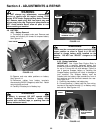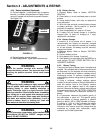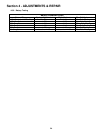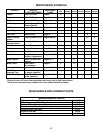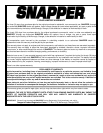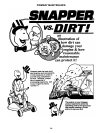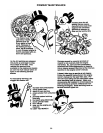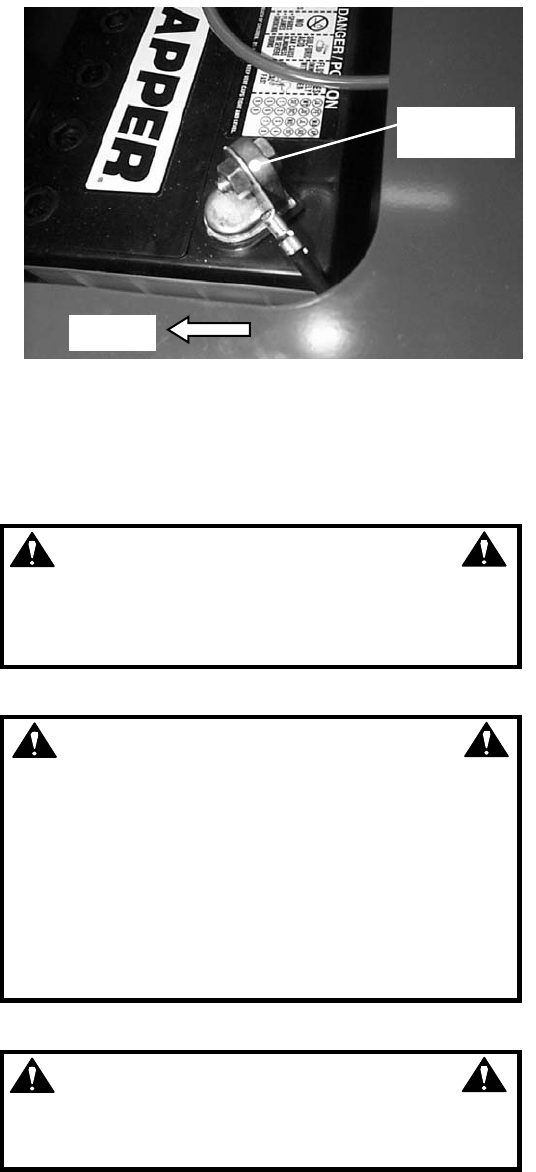
23
Section 4 - ADJUSTMENTS & REPAIR
4.8.2. Battery Installation (Continued)
3. Connect negative (-) cable (black) last, to negative
terminal (-) on battery using bolt and nut. Apply a small
amount of grease over terminals to prevent corrosion.
See Figure 4.16.
FIGURE 4.16
4. Reinstall positive terminal insulator.
5. Install seat/pedestal. Tighten seat knobs securely.
WARNING
Shield the positive terminal with terminal cover
located on battery harness. This prevents metal from
touching the positive terminal, which could cause
sparks.
WARNING
The electrolyte (acid) produces a highly explosive gas.
Keep all sparks, flame and fire away from area when
charging battery or when handling electrolyte or
battery. Electrolyte (acid) is a highly corrosive liquid.
Wear eye protection. Wash affected areas immediately
after having eye or skin contact with electrolyte (acid).
Battery acid is corrosive. Rinse empty acid containers
with water and mutilate before discarding. If acid is
spilled on battery, bench, or clothing, etc., flush with
clear water and neutralize with baking soda.
WARNING
DO NOT attempt to charge battery while installed on the
Riding Mower. DO NOT use “BOOST” chargers on the
battery. DO NOT OVERFILL!
4.8.3. Battery Service
1. Remove battery. Refer to Section “BATTERY
REMOVAL”.
2. Place battery in a well ventilated area on a level
surface.
3. Using distilled water, refill cells as required to
cover cell plates.
4. With cell caps removed, connect battery charger
to battery terminals. Red to positive (+) terminal
and black to negative (-) terminal.
5. Slow charge battery at 1 amp for 10 hours.
6. If battery will not accept charge or is partially
charged after 10 hours of charging at 1 amp,
replace with new battery.
4.8.4. Battery Storage
If machine is to be stored out of season, it is
recommended the battery be removed, charged
and stored. If the machine is stored out of season
on its rear bumper, the battery must be removed,
charged and stored.
1. Remove battery. Refer to Section “BATTERY
REMOVAL”.
2. Perform battery service.
3. Bring battery to full charge, if required.
4. Store battery in an area away from the RIDER on a
wood surface. DO NOT STORE BATTERY ON A
CONCRETE SURFACE.
4.8.5. Battery Testing
There are two types of battery tests: Unloaded and
Loaded. The unloaded test is the procedure that will
be discussed. It’s the simplest and most commonly
used. An unloaded test is made on a battery without
discharging current. To perform unloaded testing,
check charge condition using either a hydrometer or
voltmeter.
1. Using a voltmeter, voltage readings appear
instantly to show the state of charge. Remember to
hook the positive lead to the battery’s positive
terminal, and the negative lead to the negative
terminal. Measure the battery voltage and compare
to the voltages listed in the “BATTERY CONDITION
CHART” in this manual to determine condition of
battery.
2. A hydrometer measures the specific gravity of
the electrolytes in each cell. The specific gravity
tells the degree of charge; generally, a specific
gravity of about 1.265 to 1.280 indicates full charge.
A reading of 1.230 to 1.260 indicates the battery
should be charged. The “Battery Condition Chart”
included in this manual shows the charge level as
measured by syringe float hydrometer, digital
voltmeter and five ball hydrometer.
NEGATIVE
TERMIN
AL
FRONT



